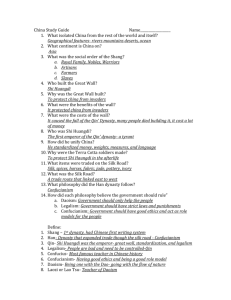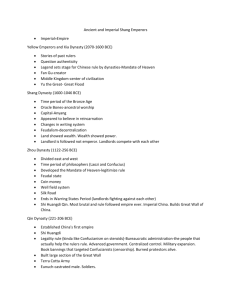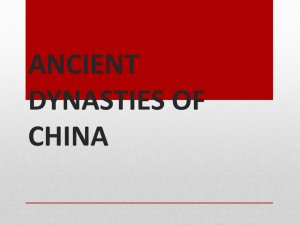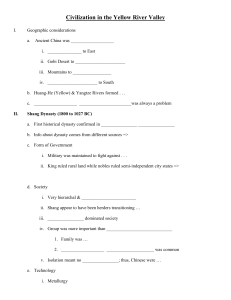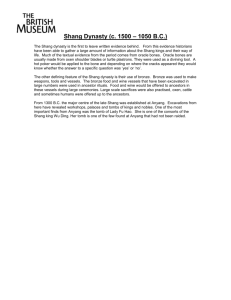Ancient China
advertisement
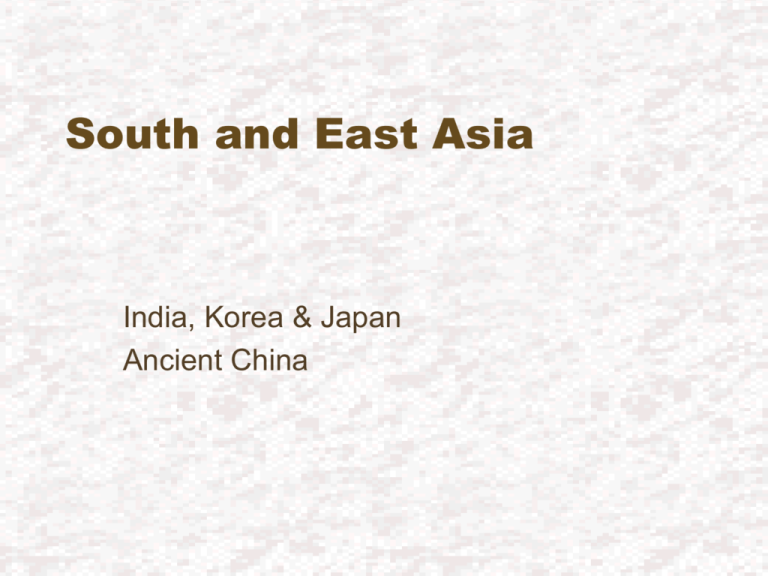
South and East Asia India, Korea & Japan Ancient China India after the Harappans • Vedic civilization was a change in Indian culture. • The Aryans adopted almost nothing of Harappan culture. They built no cities, no states, no granaries, and used no writing. • Instead they were a warlike people that organized themselves in individual tribal, kinship units, the Jana. http://www.wsu.edu/~dee/ANCINDIA/ARYANS.HTM Jana • The jana was ruled over by a war-chief. These tribes spread quickly over northern India. • The basic social unit of Aryan culture, the jana, slowly developed from an organization based on kinship to one based on geography. • The jana became a janapada, or nation and the jana-rajya , or tribal kingdom, became the janarajyapada, or national kingdom. http://www.wsu.edu/~dee/ANCINDIA/ARYANS.HTM Rigvedic Period • The earliest history of the Aryans in India is called the Rigvedic Period (1700-1000 BC) after the religious praise poems that are the oldest pieces of literature in India. • These poems, the Rig Veda, are believed to represent the most primitive layer of IndoEuropean religion and have many characteristics in common with Persian religion since the two peoples are closely related in time. http://www.wsu.edu/~dee/ANCINDIA/ARYANS.HTM Rig Veda Vedic Architecture Architecture built to conform to the natural laws, known as Vastu Shastra. http://www.gosai.com/chait anya/saranagati/html/vedicage_fs.html Architecture, con’d http://www.gosai.com/chaitanya/saranagati/html/vedic-age_fs.html Hindu Castes • By the end of the Rigvedic period, social class had settled into four rigid castes: the caturvarnas, or "four colors." • At the top of the caturvarnas were the priests, or Brahmans. Below the priests were the warriors or nobles (Kshatriya), the craftspeople and merchants (Vaishya), and the servants (Shudra), who made up the bulk of society. • These economic classes were supported by an elaborate religious system and would be eventually subdivided into a huge number of economic sub-classes which we call "castes”. http://www.wsu.edu/~dee/ANCINDIA/ARYANS.HTM Brahmanic Period • Later Vedic Period or Brahmanic Period (1000-500 BC), the Aryans migrated across the Doab, which is a large plain which separates the Yamuna River from the Ganges. • It was a difficult project, for the Doab was thickly forested; the Aryans slowly burned and settled the Doab until they reached the Ganges. • While the Rig Veda represents the most primitive religion of the Aryans during the Rigvedic Period, the religion of the Later Vedic period is dominated by the Brahmanas, or priestly book, which was composed sometime between 1000 and 850 BC. http://www.wsu.edu/~dee/ANCINDIA/ARYANS.HTM Ancient Korea • Gojoseon was an ancient Korean kingdom – Gojoseon was founded in 2333 BC by Dangun in the basins of the Liao and Taedong Rivers, ruling over northern Korean peninsula and southern Manchuria. • Gojoseon was defeated by the Han dynasty of China in 108 BC. Gojoseon bronze artifacts Three Kingdoms of Korea • The Three Kingdoms of Korea were Goguryeo, Baekje and Silla. http://en.wikipedia.org/wiki/Three_Kingdoms_of_Korea Goguryeo tomb mural The brick chamber of the tomb of King Muryeong (r. 501-523) Royal burial mounds at Gyeongju (capital of Silla) Timeline: Ancient China Neolithic ca. 12000 - 2000 B.C. Xia ca. 2100-1800 B.C. Shang 1700-1027 B.C. Western Zhou 1027-771 B.C. Eastern Zhou 770-221 B.C. 770-476 B.C. -- Spring and Autumn period 475-221 B.C. -- Warring States period Neolithic China • The Neolithic period began in China about 12,000 B.C., with the Yangshao and the Lungshan cultures • However, good evidence of Neolithic settlements exists from only about 4,000 B.C. The Neolithic lasted until about 2,000 B.C. • It is defined by a spread of settled agricultural communities, but hunting and gathering was still practiced. • The largest concentration of agriculture was below the southern bend of the Yellow River and millet was the main crop. Neolithic China Neolithic Pottery Xia Dynasty • For many years, the Xia Dynasty was thought to be a part of a myth that the Chinese tell as part of their history. • The Xia Dynasty was in oral histories, but no archaeological evidence was found of it until 1959. • The Xia were agrarian people, with bronze weapons and pottery. – The ruling families used elaborate and dramatic rituals to confirm their power to govern. – The rulers often acted as shamans, communicating with spirits for help and guidance. Erlitous • Excavations at Erlitous, in the city of Yanshi, uncovered what was most likely a capital of the Xia Dynasty. – The site showed that the people were direct ancestors of the Lungshan and were predecessors of the Shang. – Radiocarbon dates from this site indicate that they existed from 2100 to 1800 B.C. – Despite this new archaeological evidence of the Xia, they are not universally accepted as a true dynasty. http://www.mnsu.edu/emuseum/prehistory/china/ancient_china/xia.html Shang Dynasty • The Shang, rather than the Xia, is considered by most to be the first true dynasty of China. • Like the Xia, the Shang were originally considered to be a myth. • They were discovered because Chinese pharmacists were selling oracle bones the Shang had created; the pharmacists sold the bones as dragon bones. • The bones were first noticed in 1899 and by the 1920's were traced to Anyang, where the last Shang capital was found and excavated. Shang, con’d • In the 1950's an earlier Shang capital was found near present day Zhengzhou. • Traditional Chinese history indicates that the Shang Dynasty consisted of 30 kings and seven different, successive, capitals. • The Zhou, the dynasty that followed the Shang, are responsible for the recordings of the kings and capitals of the Shang Dynasty. Shang pottery Earthenware that was almost porcelain, only missing the glaze. http://www.mnsu.edu/emuseum/prehistory/china/ancient_china/shang.html Shang Writing • They are the first group of people from China of which written records are found. – The most common place these writings are found is on oracle bones used for divination. • The bones used for this purpose originally came from a number of animals, but were eventually done exclusively on turtle shells. – A question was written on the bone, which was then fired and a T shaped crack was produced which was interpreted, and the interpretation was then written on the bone. • After the predicted event occurred, the date of the occurrence was also written on the bone. – Writing is also found on bronze and stone, but the majority of the records have decayed as they were recorded on bamboo strips. http://www.mnsu.edu/emuseum/prehistory/china/ancient_china/shang.html Oracle Inscriptions Shang Religion • The Shang worshipped the "Shang Ti." • This god ruled as a supreme god over lesser gods, the sun, the moon, the wind, the rain, and other natural forces and places. • Highly ritualized, ancestor worship became a part of the Shang religion. • Sacrifice to the gods and the ancestors was also a major part of the Shang religion. • When a king died, hundreds of slaves and prisoners were often sacrificed and buried with him. People were also sacrificed in lower numbers when important events, such as the founding of a palace or temple, occurred. Zhou Dynasty • • • • • The Zhou began as a semi-nomadic tribe that lived to the west of the Shang kingdom. Due to their nomadic ways, they learned how to work with people of different cultures. After a time, they settled in the Wei River valley, where they became vassals of the Shang. The Zhou eventually became stronger than the Shang, and in about 1040 B.C. they defeated the Shang in warfare. They built their capital in Xi'an. Part of their success was the result of gaining the allegiance of disaffected citystates. Zhou Dynasty Art Qin Dynasty • The Qin came to power in 221 B.C. – They were one of the western states that existed during the Warring States Period. – They conquered the other Warring States, unifying China for the first time. • Their leader named himself the First Emperor, or Shi huangdi, thus beginning the tradition of having emperors for rulers. • The Qin, while not the most culturally advanced of the Warring States was militarily the strongest. – They utilized many new technologies in warfare, especially cavalry. – The Qin are sometimes called the Ch'in, which is probably where the name China originated. Qin Achievements • They standardized the language and writing of China, which had varied greatly from area to area during the Warring States Period. • Also, currency became standardized as a circular copper coin with a square hole in the middle. • Measurements and axle length were also made uniform. This was done because the cartwheels made ruts in the road, and the ruts had to all be the same width, or carts with a different axle length could not travel on them. • Also, a huge palace was built for Shi Huangdi, the ruler. Shi Huangdi • The Qin are also famous for the terra cotta army that was found at the burial site for Shi Huangdi. • The army consisted of 6,000 pottery soldiers that protected the tomb. They may be a replacement for the actual people who had previously been buried with the rulers. Tomb of Shi Huangdi http://www.mnsu.edu/emuseum/prehistory/china/early_imperial_china/qin.html Shi Huangdi • Located approximately 30 km outside of the present-day capital, X'ian (called Chang'an in ancient times), of the Shensi province of modern China, the tomb of Qin Shi Huangdi remains a symbol of the power and ego of China's first Emperor. • Ascending to the throne of his clan, the Qin, at the age of 13 in 246 BCE, Shi Huangdi immediately began construction of his extraordinary mausoleum which was completed soon after his death in 210 BCE, 36 years after the work commenced. http://www.utexas.edu/courses/wilson/ant304/biography/arybios98/smithbio.html View of Pit 1 http://www.anniebees.com/China/China_42.htm Terra Cotta Soldiers Soldiers http://www.anniebees.com/China/China_42.htm Calvalry Horses with Bronze Chariot http://www.anniebees.com/China/China_42.htm Infantry Details Archer from the tomb of Shi Huangdi Archer from the Back Cavalryman, Tomb of Shi Huangdi Shi Huangdi • Shi Huangdi longed for a long life, so he sent his ministers to go on quests to find a potion of immortality. • The potions they brought back may have contained arsenic and/or lead which probably hastened his death. • After his death, the Han dynasty came to power. Economy • The expansion also led to trade with the people of inner Asia. Thereafter, the Silk Road was developed. • The Silk Road actually consisted of more than one possible route through the mountains that the traders followed. • Agriculture grew with the development of better tools. Iron tools were made of better quality, and oxen drawn ploughs were commonly used. – Irrigation systems were increased to help develop the areas of North China. Crop rotation was also practiced from 85 B.C. onwards. Silk Road Chin Dynasty • Ssu-ma Yen began the Chin Dynasty; he ruled from 265-289A.D. As an emperor, he was called Wu Ti. • The Chin managed to reunify China when, in 280 A.D., they conquered the Wu Kingdom, thus ending the period of The Three Kingdoms. • After the death of Ssu-ma Yen, there was never again a strong leader. – The leaders and princes were often assassinated in the struggle for power. – During this time, the Chinese people surrounding the capital suffered due to the fighting and began a migration out from the center of the empire to the more peaceful frontier regions. Dynasties of the North and South • The Dynasties of the North and South were another lengthy period of disunity and internal strife for China. • It lasted from 317-589 A.D. During this time period, the north and south were split and two separate successions of dynasties formed. • In both the north and the south, there were different groups of rulers. Many of the dynasties overlapped each other in terms of time. T’ang Dynasty • The T’ang dynasty lasted from 618-907 A.D. – Much of their power was made possible through the canals built by the Sui. These canals allowed for communications to all parts of the empire. Also, the granaries the Sui built alongside the canals helped the T’ang to transport goods from the south to the north. This especially was important in the transfer of rice to the north in times of famine. These canals were important in the economic development of the T’ang empire. • They first compiled the T’ang Code in 624 A.D. This is the first complete Chinese code that still exists. – It consists of a continuous scale of penalties that are applied based on both the crime and the degree of relation between the criminal and the offended person. The degree was based on the amount of time that would be spent in mourning if the person died. The T’ang Code had more than five hundred articles divided into twelve sections. T’ang Art Porcelain The Female Empress • The T’ang dynasty has the distinction of having had the only female empress. • A concubine of the T’ai-tsung and Kao-tsung, named Wu Chao reigned as emperor. She removed the legitimate heir in 690 A.D. and took the throne under the name Emperor Tse-t’ien. • Her reign is actually a disruption of the T’ang dynasty, as she called her dynasty the Chou. This dynasty lasted for 15 years. • She was able to gain power largely as a result of the hidden support of the Buddhist church. They called her a reincarnation of the Bodhisattva Maitreya, a Buddhist savior. Great Walls of China • Many public works projects were also undertaken. • Several walls built as in the Zhou dynasty • The “Great Wall” was built in the north, to protect against invasions. Roads and irrigation canals were built throughout the country. The Great Wall Another accomplishment of the Ming was the building of the Great Wall. While Great Walls had been built in earlier times, most of what is seen today was either built or repaired by the Ming. The brick and granite work was enlarged, the watch towers were redesigned and cannons were placed along the wall.



